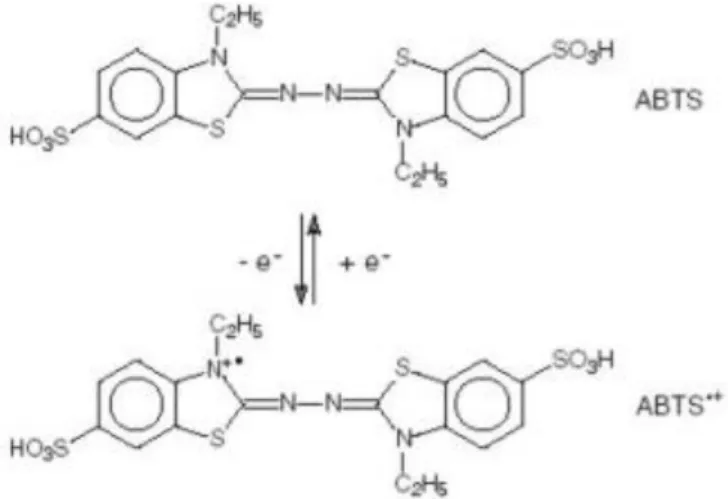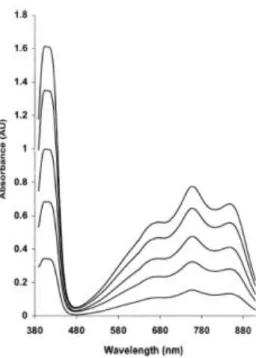1
Laboratory 8
Interaction between antioxidants and free
radicals
Instruction
for the Laboratory
Institute of Materials Science and Engineering 90-924 Łódź, 1/15 Stefanowskiego Street, building A18 phone: 42 631 30 30, office: IV floor room 440,
e-mail: inzynieria.materialowa@info.p.lodz.pl, www.mechaniczny.p.lodz.pl
1
I. THEORETICAL INTRODUCTION
Radicals (often referred to as free radicals) are atoms, molecules or ions with at least one unpaired electron in the outermost shell, and is capable of independent existence. A free radical is easily formed when a covalent bond between entities is broken and one electron remains with newly formed atom. Free radicals are highly reactive due to the presence of unpaired electron(s). Any free radical involving oxygen can be referred to as reactive oxygen species (ROS). Oxygen centered free radicals contain two unpaired electrons in the outer shell. When free radicals steal an electron from a surrounding compound or molecule a new free radical is formed in its place. In turn the newly formed radical then looks to return to its ground state by stealing electrons with antiparallel spins from cellular structures or molecules. Thus the chain reaction continues and can be "thousand of events long".
There are numerous types of free radicals that can be formed within the body. Here are mentioned only concerned with the oxygen free radicals or ROS. The most common ROS include: the superoxide anion (O 2-● ), the hydroxyl radical (OH ● ), singlet oxygen ( 1 O 2 ), and hydrogen peroxide (H 2 O 2 ).
Under normal conditions the antioxidant defense system within the body can easily handle free radicals that are produced. Oxidative stress is defined as the state in which the level of toxic reactive oxygen intermediates (ROI) overcomes the endogenous antioxidant defences of the host. This state results in an excess of free radicals, which can react with cellular lipids, proteins, and nucleic acids, leading to local injury and eventual organ dysfunction. Lipids are probably the most susceptible biomolecule to free radical attack. So, free radicals have been implicated as playing a role in the etiology of cardiovascular disease, cancer, Alzheimer's disease and Parkinson's disease.
Free radicals come from two major sources: endogenous and exogenous. Endogenous free radicals are produced in the body by the following different mechanisms:
from the normal metabolism of oxygen.
blood cells destroy parasites, bacteria and viruses by using oxidants such as nitric oxide, superoxide and hydrogen peroxide.
cellular components called peroxisomes produce hydrogen peroxide as a byproduct of the degradation of fatty acids and other molecules.
Exogenous sources of free radicals include air pollution, of which industrial waste and cigarette smoke (both active and passive), radiation (from industry, sun exposure, cosmic rays, and medical X-rays). The trace metals, notably lead, mercury, iron and copper are also major sources of free radical generation. Alcohol, unsaturated fat and normal diets containing plant foods with large quantities of certain compounds such as phenols and even caffeine may contribute to the exogenous supply of oxidants to the body.
1
dismutase (SOD), catalase, and glutathione peroxidase, that neutralize many types of free radicals. In addition to enzymes, many vitamins and minerals act as antioxidants in their own right, such as vitamin C, vitamin E, beta-carotene, lutein, vitamin B 2 , coenzyme Q10, and cysteine (an amino acid). Herbs, such as bilberry, turmeric (curcumin), grape seed or pine bark extracts, and ginkgo can also provide powerful antioxidant protection for the body.
II. MEASUREMENT PRINCIPLE OF THE TOTAL ANTIOXIDANT CAPACITY
Total antioxidant capacity (TAC) of tested substance indicates its ability to prevention of oxidation reactions in exactly defined conditions. Generally, in this exercise the speed of scavenging of free radicals by various antioxidants will be determined.
The spectopthometric method using synthetic radical of ABTS (2,2′-azino-bis(3-ethylbenzothiazoline-6-sulfonic acid) diammonium salt) will be used to calculate TAC of the selected substances (Fig. 1).
Fig. 1. ABTS and its one-electron oxidation product, ABTS •+
The colorless ABTS molecule is converted into the blue-green colored radical, ABTS •+ , by oxidation of one-electron, as depicted in Fig. 1. ABTS •+ has absorption maxima at wavelengths 645 nm, 734 nm and 815 nm, as well as the more commonly used maximum at 415 nm (Fig. 2). Oxidation of the ABTS commenced immediately, but the absorbance was not maximal and stable until more than 6 h had elapsed. The maximum of absorbance is achieved after 12-16 h. Addition of antioxidants to the pre-formed radical cation reduces it ABTS, to an extent and on a time-scale depending on the antioxidant activity, the concentration of the antioxidant and the duration of the reaction. Decrease of the absorption after addition of antioxidants is directly proportional to the number of ABTS •+ radicals.
Institute of Materials Science and Engineering 90-924 Łódź, 1/15 Stefanowskiego Street, building A18 phone: 42 631 30 30, office: IV floor room 440,
e-mail: inzynieria.materialowa@info.p.lodz.pl, www.mechaniczny.p.lodz.pl
1
Fig. 2. Absorption spectrum of the ABTS radical cation.
III. INSTRUCTIONS
1. Preparation of the reagents
a) Starting solution of ABTS: dissolve 19,5 mg of ABTS and 3,3 mg of potassium persulfate in 7 ml ddH2O (deionized water). Mixture should be incubated for 12h before use. (It should be prepared a day before exercise by the instructor and should be kept frozen -20).
b) Dilute of starting ABTS solution to an absorbance of 1,00±0,02 at 414 nm. c) Prepare 5 mM solution of ascorbic acid in water.
d) Prepare Trolox with concentration of 25 mol/dm3 and its dilution e) Prepare a fresh juice of carrot and citron
2. Assay protocol
a) Measure the absorbance of diluted ABTS•+ at 414 nm. (A0)
b) Take 0,96 ml of diluted ABTS•+ to a cuvette and add 40 μl of ddH2O. Measure an
absorbance immediately after mixing at 414 nm (Ablanc) up to 1 min at 5s intervals.
Incubate control sample in dark for 15 min and then read absorbance
c) To prepare standard curve take 0,96 ml of diluted ABTS•+ to a cuvette and add 40 μl of prepared dilution of Trolox. Measure an absorbance immediately after mixing at 414 nm (Ablanc)
1 2
d) Prepare control samples: mix 0,96 ml of diluted water and 40 μl of each antioxidants Read an absorbance at 414 nm immediately after mixing up (Ak)
e) Prepare a tested sample: mix 0,96 ml of diluted ABTS•+ and 40 μl of each antioxidants. Read an absorbance at 414 nm immediately after mixing up. As a blanc use a water (Apw)
3. Results
a) prepare standard curve on the basis of results taken form point 2c b) Measure an absorbance:
Aw=Apw-Ak
where:
Apw - absorbance of diluted ABTS•+ after incubation with antioxidant taken from
point 2 e
Ak - absorbance of control sample for each antioxidant taken from point 2 d
c) Measure the ability to counteract oxidation reaction [%inhibition]=100(A0-Aw)/A0
d) Measure the drop of absorbacne of ABTS•+ after adding atioxidant: ΔA=(Apw-Ablanc)
IV. THE REPORT The report should include: 1. Short introduction. 2. The aim of the exercise. 3. The table with the results. 4. Discussion and conclusions.
V. LITERATURE
1. B. Halliwell, J.Gutteridge, Free radicals in biology and medicine. Oxford University Press, 2005

